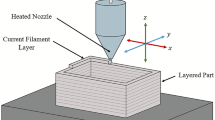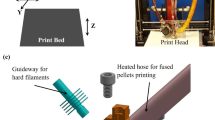Abstract
The extrusion system is an integral part of any fused deposition style 3D printing technique. However, the extruder designs found in commercial and hobbyist printers are mostly suitable for materials in filament form. While printing with a filament is not a problem per se, the printing of materials that may not be readily available in the filament form or not commercially viable remains untapped, e.g., biopolymers and material blends. This is particularly an issue in the research and hobbyist space where the capability of printing a variety of materials or materials recycled from already printed parts may be of utmost importance. This paper presents a pellet-based extrusion system for the 3D printing of biopolymers. The system has been designed from the first principles and therefore can be extended to other materials with parameter adjustments or slight hardware modifications. A robust mechatronic design has been realized using an unconventional yet simplistic approach. The extrusion system uses a series of control factors to generate a consistent output of material over the course of a print. The platform and surrounding processes are set up so that software can be used to define the printing parameters; this allows a simpler adaption to different materials. The utility of the extruder is demonstrated through extensive printing and testing of the printed parts.
Similar content being viewed by others
References
Agarwala MK, Jamalabad VR, Langrana NA, Safari A, Whalen PJ, Danforth SC (1996) Structural quality of parts processed by fused deposition. Rapid Prototyp J 2(4):4–19
Ahn D, Kweon JH, Kwon S, Song J, Lee S (2009) Representation of surface roughness in fused deposition modeling. J Mater Process Technol 209(15-16):5593–5600
Bak D (2003) Rapid prototyping or rapid production? 3D printing processes move industry towards the latter. Assem Autom 23(4):340–345
Béreaux Y, Charmeau JY, Moguedet M (2009) A simple model of throughput and pressure development for single screw. J Mater Process Technol 209(1):611–618
Brooks BJ, Arif KM, Dirven S, Potgieter J (2017) Robot-assisted 3D printing of biopolymer thin shells. Int J Adv Manuf Technol 89(1–4):957–968
Covas J, Costa P (2004) A miniature extrusion line for small scale processing studies. Polym Test 23(7):763–773
Crump SS (1992) Apparatus and method for creating three-dimensional objects. US Patent 5,121,329
Dul S, Fambri L, Pegoretti A (2016) Fused deposition modelling with ABS–graphene nanocomposites. Compos A: Appl Sci Manuf 85:181–191
Durgun I, Ertan R (2014) Experimental investigation of FDM process for improvement of mechanical properties and production cost. Rapid Prototyp J 20(3):228–235
Gurrala PK, Regalla SP (2014) Part strength evolution with bonding between filaments in fused deposition modelling: this paper studies how coalescence of filaments contributes to the strength of final FDM part. Virtual and Physical Prototyping 9(3):141–149
Haigh JN, Dargaville TR, Dalton PD (2017) Additive manufacturing with polypropylene microfibers. Mater Sci Eng C 77:883–887
Hunt EJ, Zhang C, Anzalone N, Pearce JM (2015) Polymer recycling codes for distributed manufacturing with 3-D printers. Resour Conserv Recycl 97:24–30
Kruth JP, Leu MC, Nakagawa T (1998) Progress in additive manufacturing and rapid prototyping. CIRP Ann Manuf Technol 47(2):525–540
Marlin (2017) Open source 3D printer firmware. https://github.com/MarlinFirmware/Marlin
Pinho ED, Martins A, Araújo J, Reis R, Neves N (2009) Degradable particulate composite reinforced with nanofibres for biomedical applications. Acta biomaterialia 5(4):1104–1114
Prince JD (2014) 3D printing: an industrial revolution. Journal of electronic resources in medical libraries 11(1):39–45
Ranellucci A (2017) Slic3r g-code generator for 3D printers. https://github.com/alexrj/Slic3r
RepRap (2017) Ramps 1.4. http://reprap.org/wiki/RAMPS1.4
Salea A, Prathumwan R, Junpha J, Subannajui K (2017) Metal oxide semiconductor 3D printing: preparation of copper (ii) oxide by fused deposition modelling for multi-functional semiconducting applications. J Mater Chem C 5(19):4614–4620
Schubert C, Van Langeveld MC, Donoso LA (2013) Innovations in 3D printing: a 3D overview from optics to organs. British Journal of Ophthalmology pp bjophthalmol–2013
Sood AK, Ohdar RK, Mahapatra SS (2010) Parametric appraisal of mechanical property of fused deposition modelling processed parts. Mater Des 31(1):287–295
Sun Q, Rizvi G, Bellehumeur C, Gu P (2008) Effect of processing conditions on the bonding quality of FDM polymer filaments. Rapid Prototyp J 14(2):72–80
Turner BN, Gold SA (2015) A review of melt extrusion additive manufacturing processes: II. materials, dimensional accuracy, and surface roughness. Rapid Prototyp J 21(3):250–261
Tymrak B, Kreiger M, Pearce JM (2014) Mechanical properties of components fabricated with open-source 3-D printers under realistic environmental conditions. Mater Des 58:242–246
Valkenaers H, Vogeler F, Ferraris E, Voet A, Kruth JP (2013) A novel approach to additive manufacturing: screw extrusion 3D- printing. In: Proceedings of the 10th international conference on multi- material micro manufacture, Research Publishing, pp 235–238
Wang J, Xie H, Weng Z, Senthil T, Wu L (2016) A novel approach to improve mechanical properties of parts fabricated by fused deposition modeling. Mater Des 105:152–159
Wong KV, Hernandez A (2012) A review of additive manufacturing. ISRN Mechanical Engineering 2012
Acknowledgements
The authors thank Dr. Marie-Joo Le Guen for providing the materials and related expertise.
Funding
This research was part of the Extrusion Plus program led by Scion New Zealand and funded by the Ministry of Business, Innovation, and Employment (MBIE) funding under High Value Manufacturing and Services (HVMS) Enabling Technologies investment contract.
Author information
Authors and Affiliations
Corresponding author
Rights and permissions
About this article
Cite this article
Whyman, S., Arif, K.M. & Potgieter, J. Design and development of an extrusion system for 3D printing biopolymer pellets. Int J Adv Manuf Technol 96, 3417–3428 (2018). https://doi.org/10.1007/s00170-018-1843-y
Received:
Accepted:
Published:
Issue Date:
DOI: https://doi.org/10.1007/s00170-018-1843-y




